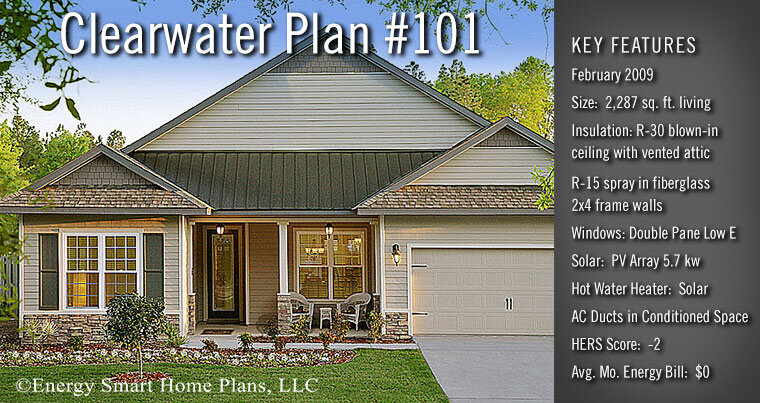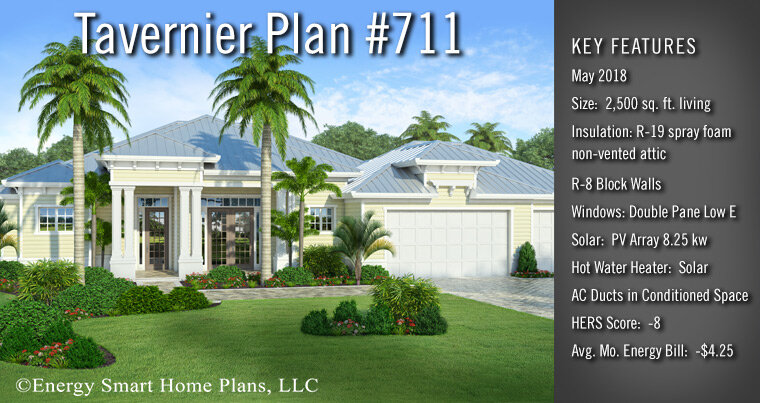Net-Zero by Design
Our home plans have the key energy-efficient features already designed in.
First Net-Zero Energy Home in the southeastern United States.
Net-Zero by Design – Part 1 – In my last blog series, Custom Home Design, I revealed the interviewing process to prior to beginning Task I, Preliminary Design. Although the process of discovering our client’s evolving wish list continues even through the building process, I do my best to learn as much as possible up-front to accomplish our work, the home design and for local clients, typically all of the related drawings necessary to obtain a building permit.
Ft. Myers, Florida Net-Zero Energy Home – May 2018
In this blog series, I’ll discuss the interviewing process for our clients who seek out Energy Smart Home Plans for the design of the most energy efficient homes. In an effort to not repeat my Custom Home Design blog series, I’ll attempt to keep this Net-Zero Energy Home blog series focused on that goal. With the exception of modifying existing Energy Smart Home Design Plans, the interviewing process included in the Custom Home Design blog series applies here too. I’ll likely follow up with another blog or two regarding the process of modifying our Energy Smart Home Plans.
I want to say that my involvement in the cutting-edge world of hi-performance and Net-Zero Energy Home design would not have occurred without the advice, education and prodding by Ken Fonorow of Florida Hero. Ken is a building scientist from Gainesville, Florida and as far as I’m concerned, his contribution to energy-efficient home design and construction should by now have made him a household name! Ken would say that “performance” is much better than fame. Typical of his dedication to his craft, Ken’s slogan is appropriately, “Part of the solution, one home at a time.” I did not consult with Ken while writing this Net-Zero Energy Home blog series and because my explanations are intentionally brief, Ken would no doubt point out a few over simplifications. I’ll do my best to recount the golden nuggets he’s taught me!
For the record, a Net-Zero Energy Home consumes no more energy then it produces over a twelve month period. Designing a healthy, durable and comfortable home yet with a mechanical system that consumes very little energy is the greatest impact we can make towards making a Net-Zero Energy Home affordable to build and own. I’ll explore this much more in coming blog entries. Wanting to avoid a dull blog series quoting numbers, stats and energy bills, I’ll weave the principles of designing and building hi-performance homes with real life experiences.
The Tavernier -8 HERS Score Certification
Having designed the first true Net-Zero Energy Home in the Southeast and built by Tommy Williams Homes, (ESHP Plan#101 Clearwater), we have some authority on the design and building of super energy efficient and Net-Zero Energy Homes, particularly in hot and humid climates. Because the principles remain basically the same, we’ve also enjoyed great success in colder climates too. Since that first Net-Zero Energy Home commissioned on January 1st, 2010, we’ve designed well over 200 homes, all can be built as hi-performance homes. With the addition of solar PV, many are affordably built Net-Zero Energy Homes. The latest certified Net-Zero Energy Home (-8 HERS) we designed is in our home town of Fort Myers, Florida. Hi-Performance builder Shawn Harvey of Greencastle inc., just completed in May of 2018, the 2500 sq. ft. lovely Florida Coastal home that will have an estimated -$51 annual energy bill. Yes, that’s a minus sign! See the 711 Tavernier here.
Net-Zero by Design
We attract many educated consumers who do plenty of research before our first meeting. Most have found their information on manufacturer’s and “so called” green building websites and publications. While generally helpful, often times the information can be misleading. Not every great product or procedure is right for every location or application! We advocate products and procedures that offer the most “bang for the buck,” that is to say, products that make financial sense. The goal is to design the best house for the client that also has the lowest possible energy costs, for the least amount of money. I think there is no reasonable rationale for spending hard-earned dollars on solar panels or other expensive products on what is an existing “energy hog” home. Energy savings is not just about solar panels, its a comprehensive approach resulting in the lowest energy costs possible. At the risk of being deluged by emails I also think it does not make sense to pay more for solar PV then the cost of the energy it replaces. Perhaps it’s even controversial to say that I’ve heard well-meaning green building professionals strongly advocate “the need to do the right thing,” as long as it’s their client’s money that’s paying for it.
Stay tuned for Part 2 of the Net-Zero by Design blog series.




